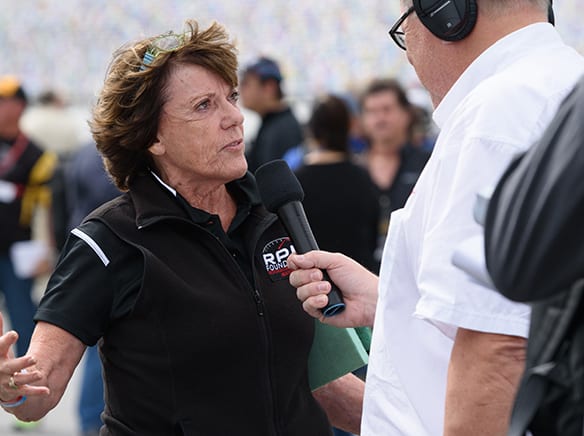
DAYTONA BEACH, Fla. – Just a quick look at Lyn St. James’ March calendar gives good insight into her varied schedule. One Wednesday she’s doing an interview for Women’s History Month, another Sunday she’s waving the green flag for the NASCAR Cup Series race at her hometown Phoenix Raceway.
There are movie filming dates and advisory meetings for a diversity group, capped by a reminder of the Zoom opening of The Henry Ford’s “Driven to Win: Racing in America” exhibit outside Detroit where she’s featured.
It’s a wonderful snapshot of St. James’ day-to-day work, a time-stamp glimpse of her varied passions and callings.
A two-time class winner in the Rolex 24 At Daytona, a class winner at the Twelve Hours of Sebring and the 1992 Indianapolis 500 Rookie of the Year, St. James has had a celebrated career in motorsport – a notable multi-chapter impact that is an essential sporting contribution to be recognized during March’s Women’s History Month. And every other month as well.
St. James is a history-maker. She has trailblazed in the male-dominated realm of auto racing and been a true pioneer long before her contributions and triumphs were even fully recognized or appreciated.
What truly stands out, however, is the dedication to the work St. James has put in outside the cockpit – to further the careers of other young women following in her racing footsteps. She is an inspiration for those unwilling to settle for a misguided “no, you cannot” whether steering a car or maneuvering through life’s other challenges.
“Everybody sees me mostly as this race car driver and I’m OK with that, I mean, that’s what I focused on,’’ St. James said. “But over the decades, I’ve had so many things that have opened up and come to me.
“Over time, it took me a lot longer to understand I need to think bigger than just about me and that was a gift I was given over the years, working with the Women’s Sports Foundation, that I started to understand the value of that,’’ St. James continued.
“It’s opened a variety of things for me and I’m proud of that. I am. I’m very proud of what I did in racing, but I think those other things that have come along have helped me grow, and I think it’s helped the sport grow. Although it may not have known it. It helped me grow as a person, I got a bigger view of the world.”
“I had a role model in (tennis great) Billie Jean King and what I saw other athletes were doing for their sports whether it was golf or tennis or basketball. The creation of the WNBA. I was fortunate to be exposed to other female athletes making a difference in their sport. I’d have to be blind to not see that’s just the right thing to do.”
During the 1980s and ‘90s, in particular, St. James’ work behind the wheel was historic. She wasn’t earning headlines because she was a woman in a man’s sport. She was legitimately earning headlines because she was a race contender and class winner. She wasn’t entering races for a “participation award,” St. James’ intent was to win – just as it was for her competitors.
She raced for those wins with the famed Jack Roush team in what is now the IMSA WeatherTech SportsCar Championship and eventually moved into the IndyCar spotlight – her entry in the 1992 Indy 500 marking the first time a woman had competed in the celebrated race since Janet Guthrie in 1979.
The attention St. James carried into her Indy 500 debut and the impressive 11th-place finish – and rookie honors – earned massive media attention. Soon, St. James was a household name even to those who may not necessarily follow the sport closely.
That recognition and her obvious relatability became resources for her and helped her guide and support young female racers for years with her Women in the Winner’s Circle Foundation. As with other athletes she respects, St. James has committed to making as big a difference out of the car as she did in the car.
“I love the sport so much and I’ve learned so much about the sport. I know I’m a good communicator and I know I can be an effective ambassador,’’ St. James said.
“People walk away from me after a conversation about racing knowing more about the sport and being much more intrigued and interested in the sport than before we had that conversation. So, if there’s anything I’m pleased about, it’s because I reach a lot of different audiences.
“I like being able to carry the message because I love the sport so much and it’s given me so much that I really, really enjoy telling people my perspective and my story – not just my personal story but why I think the sport is so great.”
That motivation to do more – to be more – has made the same kind of impact as her trailblazing successes in the cockpit.
“There are too many extraordinary moments, so the only answer I can give is the thing that makes me feel most proud is that I’ve had a long career in the sport,’’ St. James said.
“We know there have been many, many great drivers that have done a lot more than I have, but they aren’t around anymore – not because they died, but because they just left the sport whether by choice or because the sport can be very cruel. If you aren’t necessarily valued or your currency is not marketable or valuable, it can be a very cruel sport.
“So, I think the thing I’m most proud of is that I’m still in it. I still love it. And people seem happy to see me.”
